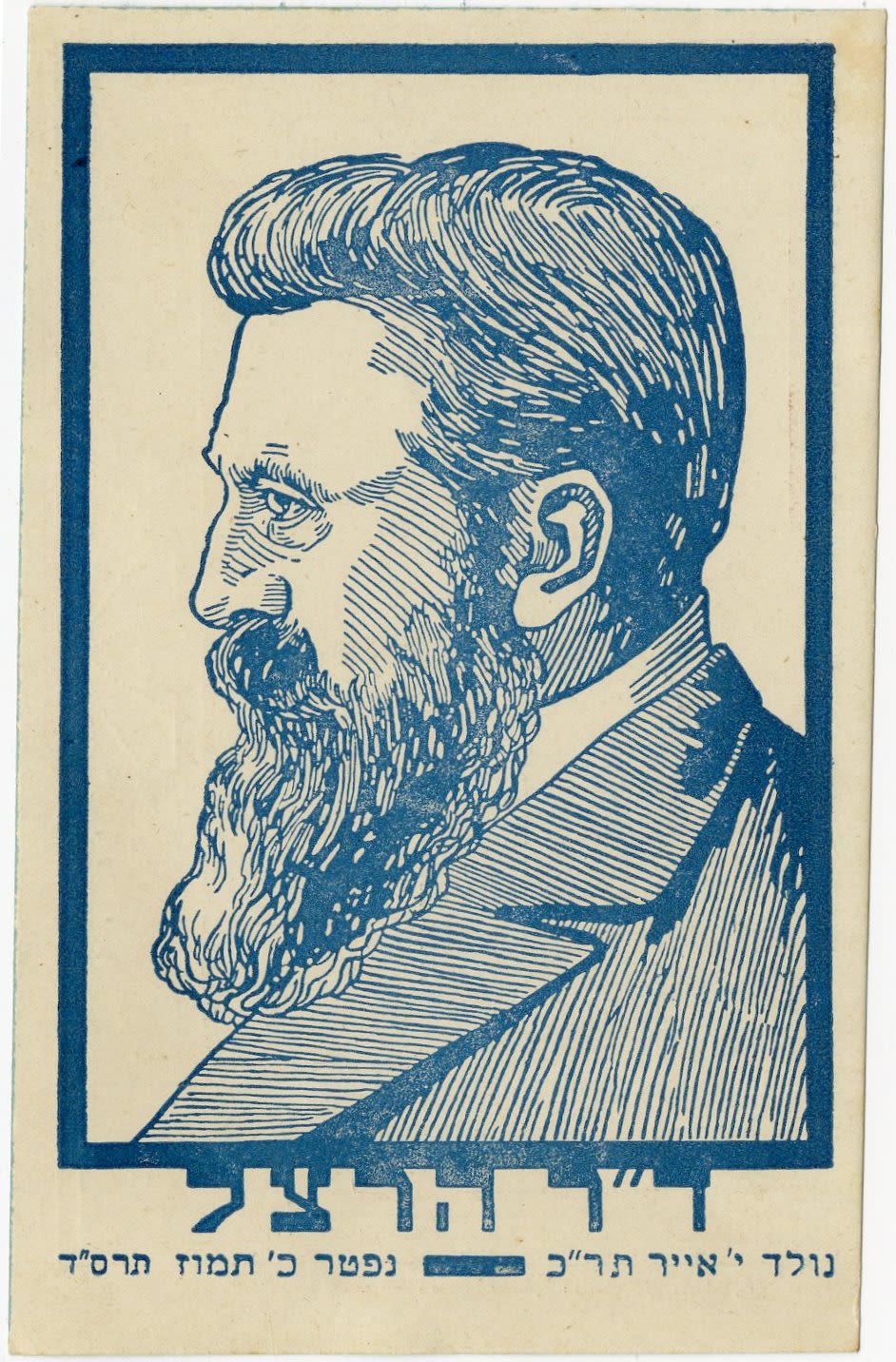
10 postcards of Jewish personalities and Zionist leaders, various places, early 20th century. Among them: Theodor Herzl - an early postcard published by H. Goldberg - Warsaw, Baruch Spinoza, Benjamin Rothschild ('The Well-known philanthropist' - Moshe Halutz Publishing), Dr. Yehuda Leib Pinsker - Lebanon Publishing Warsaw, Avshalom Feinberg - Founder of the Nili underground, Sarah Aaronson, Aaron Aaronson, Israel Zangwill, and others.
Two postcards were used. Some have stains. general condition good.

Two large photographs from the 15th World Zionist Congress held in Basel, Switzerland, August-September 1927. Signed with the Congress photographer's ink stamp - Robert Sprang - Basel.
* Photo of the interior hall where the congress was held in the casino building on its many participants, and the deputies. The president of the Zionist Organization, Haim Weizmann, gives a speech, and on both sides are members of the presidency. In the center of the wall behind the stage can seen a large picture of Theodor Herzl. Size: 21x17. Signed on the back with the stamp of the photographer Robert Spreng - Basel.
* A group photograph of the delegates of the Congress who participated in the First Zionist Congress stands on the balcony to a group photograph marking the 30th anniversary of the first Congress. In the photographs can be seen Nahum Sokolov, Leib Yaffe, Menachem Ussishkin, Arie Leib Motzkin, Berthold Feibel, Isidore Shalit, Meir Avner, Aharon Kaminka and others. Size: 21x15 cm. Signed on the back with the ink stamp of the photographer Robert Spreng - Basel.
Both photographs are in very good condition.
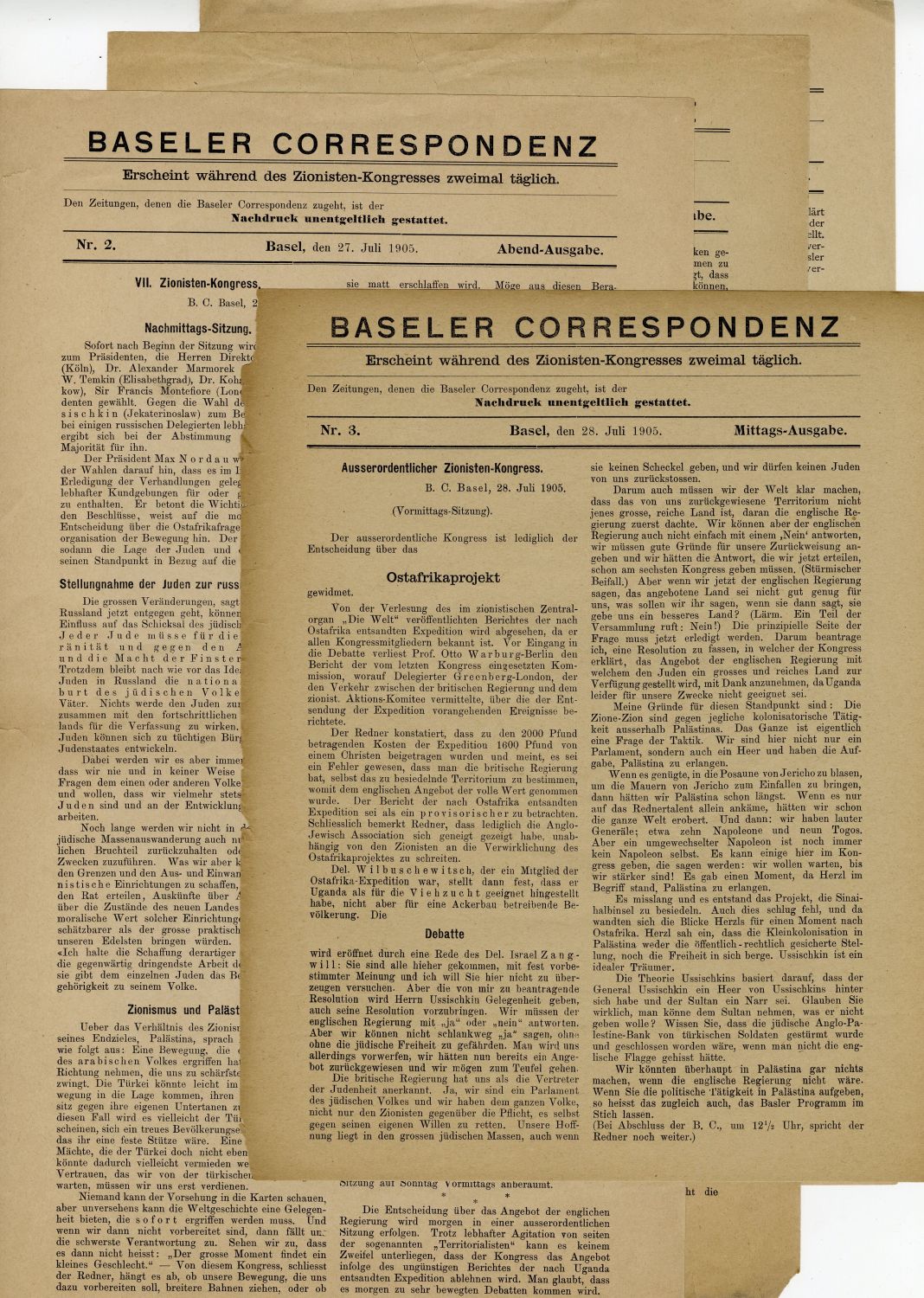
Baseler correspondenz - a daily newspaper published twice a day during the Seventh World Zionist Congress in Basel 1905 - morning edition, and noon-evening edition. The paper reviewed congressional speeches and audience occurrences during, before, and after speeches, as well as the congressional decision-making process. Each issue is one-page. Before us issues 2, 3, 4, 6. Very rare.
Interesting reports from the Congress rooms and the main hall. The newspaper reports on both the content of the speeches delivered and the interim reactions of the audience: "Noise in the hall, some of those gathered shout: No! ", Or for example:" Dr. Nordau's speech was interrupted by loud applause ... The chairman managed to hold the afternoon A relatively quiet session ... Nordau spoke about the ultimate goal of the Zionist movement - a state in Palestine ... The Turkish government can intervene in solving the Arab problem ... ". There are reports of the various deputies and their opinions. Reports on the Zionist movement's efforts with the British government, the continuation of the Zionist movement without Herzl (who died about a year earlier), as well as the content of the speeches on the pros and cons of Uganda's proposal, and more. In the summaries of the speeches that came out after each and every congress, there was no description at all of what was happening on the part of the audience, and of interim reactions. Hence the importance of the sheets before us which describe above all, the internal occurrence in the Congress Hall.
Sheets in different sizes: 30x23 cm, and 43x23 cm. general condition very good .

A photograph of Albert and Elsa Einstein in the courtyard of the War and Navy Building in Washington - as part of Einstein's visit to the United States in 1921. Described and dated on the back in German: Marinegebäude Washington 1921 - "Washington Navy Building 1921". The two's stay in the United States was shortly before Einstein won the Nobel Prize in Physics for discovering the law of the photoelectric effect.
Photo size: 14.5x11 cm. Pasted to the photographer's original cardboard: 21x15.5 cm. Stains. Good condition.
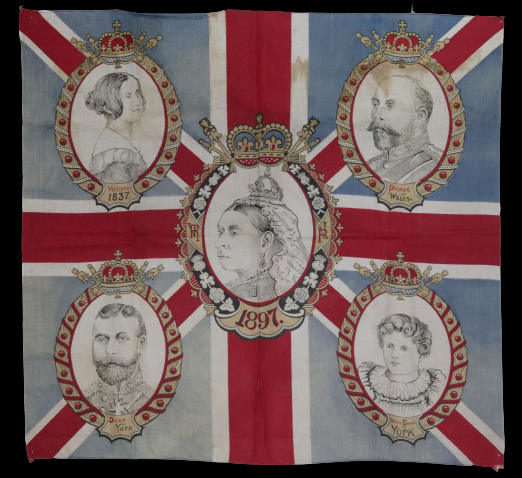
Flag of Britain - Queen Victoria - Fabric Embroidery 1897. In the center is a portrait of Queen Victoria, surrounded by her family, the princes of Wales and York. At the top left is a portrait of Queen Victoria in her youth at the age of 18 in 1837 - the year she began her tenure.
Victoria, Queen of the United Kingdom [1819-1901] Granddaughter of King George III, and last British control of the House of Hanover. Victoria was Queen of the United Kingdom from 20 June 1837 until her death, for 63 years and seven months, more than any British king who preceded her. She was also the first Empress of India, beginning on May 1, 1876. Her reign is named after her, "the Victorian period". It was the heyday of the Industrial Revolution, in which the United Kingdom underwent many developments in the fields of society, economy and technology. During her reign the British Empire grew greatly, and was considered the most powerful empire in the world. Victoria is considered one of the most powerful women in human history in general.
A similar flag is known in which Queen Victoria is seen in the center against the background of the British flag without the princes. The version before us is rarer.
Size: 70x72 cm. Stains. Good condition.
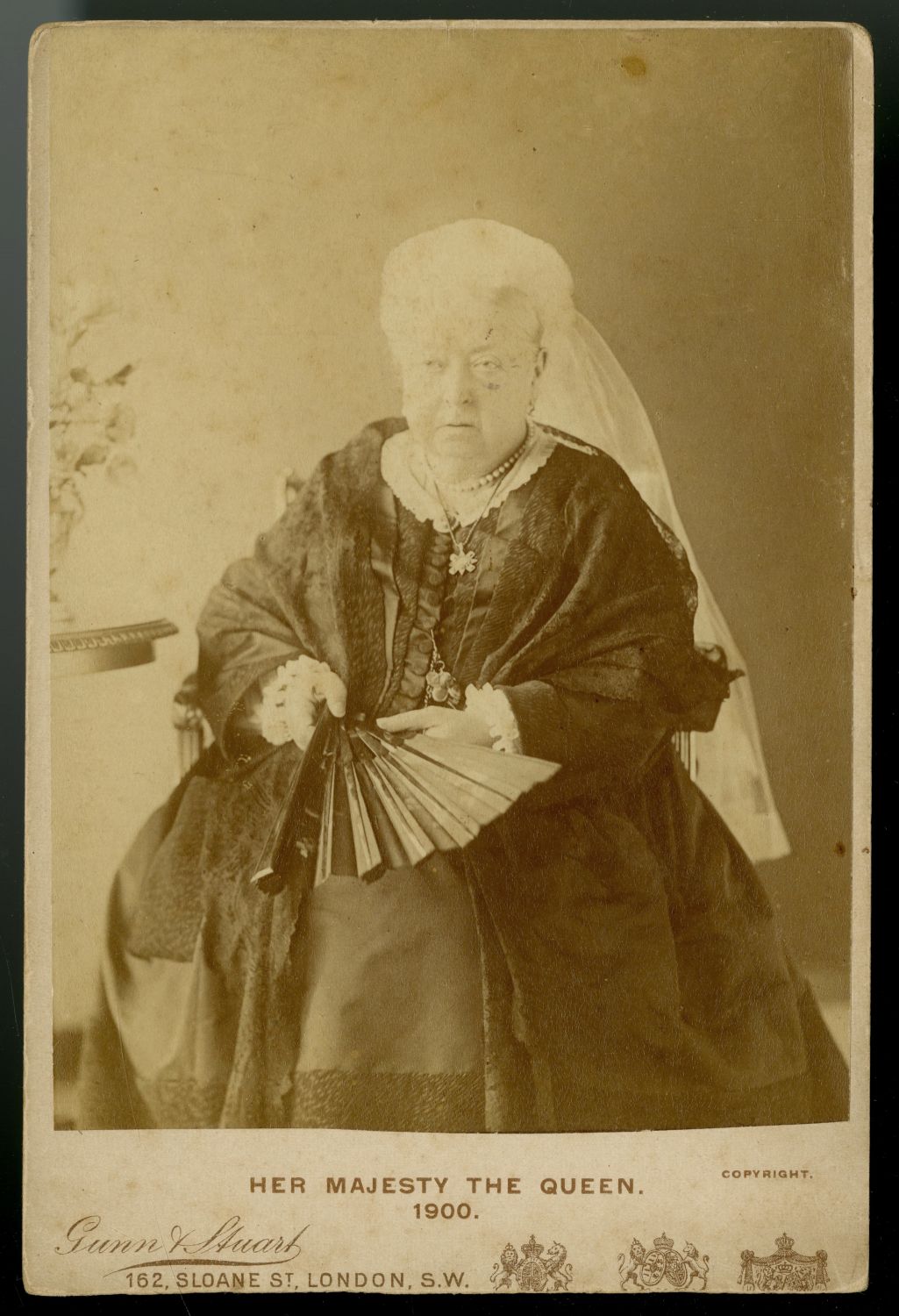
HER MAJESTY THE QUEEN 1900 - A large photograph of the Queen of the United Kingdom Alexandrina Victoria [1819-1901]. Photographed in 1900, about a year before her death. photographer: Gunn Stuart, London.
Victoria, Queen of the United Kingdom (Alexandrina Victoria, 1819-1901) from 20 June 1837 until her death. She reigned for 63 years and seven months, more than any British king who reigned before her. She was also the first Empress of India, beginning on May 1, 1876. Her reign is named after her, "the Victorian period". It was the heyday of the Industrial Revolution, in which the United Kingdom underwent many developments in the fields of society, economy and technology. During her reign the British Empire grew greatly, and was considered the most powerful empire in the world. Victoria was the granddaughter of King George III, and the last British ruler of the House of Hanover. Victoria is considered one of the most powerful women in human history in general.
Size: 17x11 cm. Glued to the photographer's hard substrate. Very good condition .
.

Portrait of Karl Marx - Flag embroidered silk fabric, hanging and sewn to an old wooden strip. Made in the textile factory "East Is Red". Hangzhou, China. the 50's.
In pre-communist revolution China in 1954, most silk weaving was done in family workshops in Hangzhou city. During the 1950s, when China advanced to industrial creation, and private sewing shops began to close one by one, several examples were created that illustrated the Chinese Industrial Revolution — one of which is a portrait of Karl Marx before us. The portrait of Marx, created at the "East Is Red" textile factory (named after the popular anthem of the Chinese Cultural Revolution), like other public actions taken by Mao Zedong, was intended to be hung in public places across China. The portrait characterized the Chinese renunciation of China’s long-standing traditional customs and return to the ancestors of communism. Silk itself symbolized one of the hallmarks of Chinese pride, as according to Chinese tradition, China was the first country to start producing silk fabrics thousands of years ago. The reason why the figure of the Jewish Marx was chosen to represent the Chinese textile revolution was because in his early writings Marx harshly criticized the exploitation and capitalist abuse of workers in the textile factories, he argued that the proletariat was employed in harsh working conditions and meager wages. In Marx's early vision in his writings of 1844 he presents the textile workers to be the first whose terms of employment would improve as a result of the communist revolution. In doing so, the Chinese expressed the new way of gender equality in creating many sources of employment for textile workers, and taking them out of private hands. The revolution yielded results and to this day Hangzhou is one of the industrialized city in China, houses the National Silk Museum of China. The city is industrialized in a wide variety of fields of tourism, agriculture, textiles, and light industry, and is often compared to the Silicon Valley of the United States.
Size: 72x49 cm. Few stains. good - very good condition.

SUBURBAN TELEPHONE DIRECTORY Containing Lists of Subscribers in Places Suburban to New York City May 1924 - Telephone Directory of the Suburbs of New York City. published by NEW YORK TELEPHONE COMPANY 1924. Extremely rare.
Thick guide includes four-digit telephones from New Jersey residents, Rockland County the city of Tuxedo, Westchester and Putnam counties, New Canaan and the surrounding area.
The instructions to the guide state that the guide is provided to residents free of charge, but on loan, and that it is the property of the telephone company. When a new guide comes out this guide should be returned to the company courier who provides the new guide. There are also price rates for calls to private destinations, and to public destinations according to the duration of the call, instructions on how to connect a new line through the company representative, the difference in call rates according to the distance between the different areas. There are also advertisements for manufacturing companies in New York and the surrounding area.
The New York Public Library lists telephone directories of New York and the surrounding area that have been digitized, from 1786 to 1922 (non-consecutive). This year (1924) does not appear in the New York Library collection.
910 [2] p. 30 cm. Time stains and signs of use.

A particularly scathing proclamation by the Irgun after the events of the Great Arab Revolt that took place in 1936-1939, calling for a war against the Arab enemy after - "three years or more of massacre of Jews in the homeland ...".
"Workers !! Hebrew youth ... one war now for all of us, a war on the enemy, who wants to pillow our hopes and our future, a war by rebellion, blood and fire! ... Increase the number of Arab deads in Jerusalem, Haifa and the rest of the country! ... and become The staged "resistance" of your leadership to the beginning of a Hebrew uprising in its homeland, as befits the grandsons of the Maccabees and the Kanaim ... In blood and fire we will consume the decrees of the enemy and liberate the homeland".
[1] leaf. 33x22 cm. Stencil printing. Very good condition.
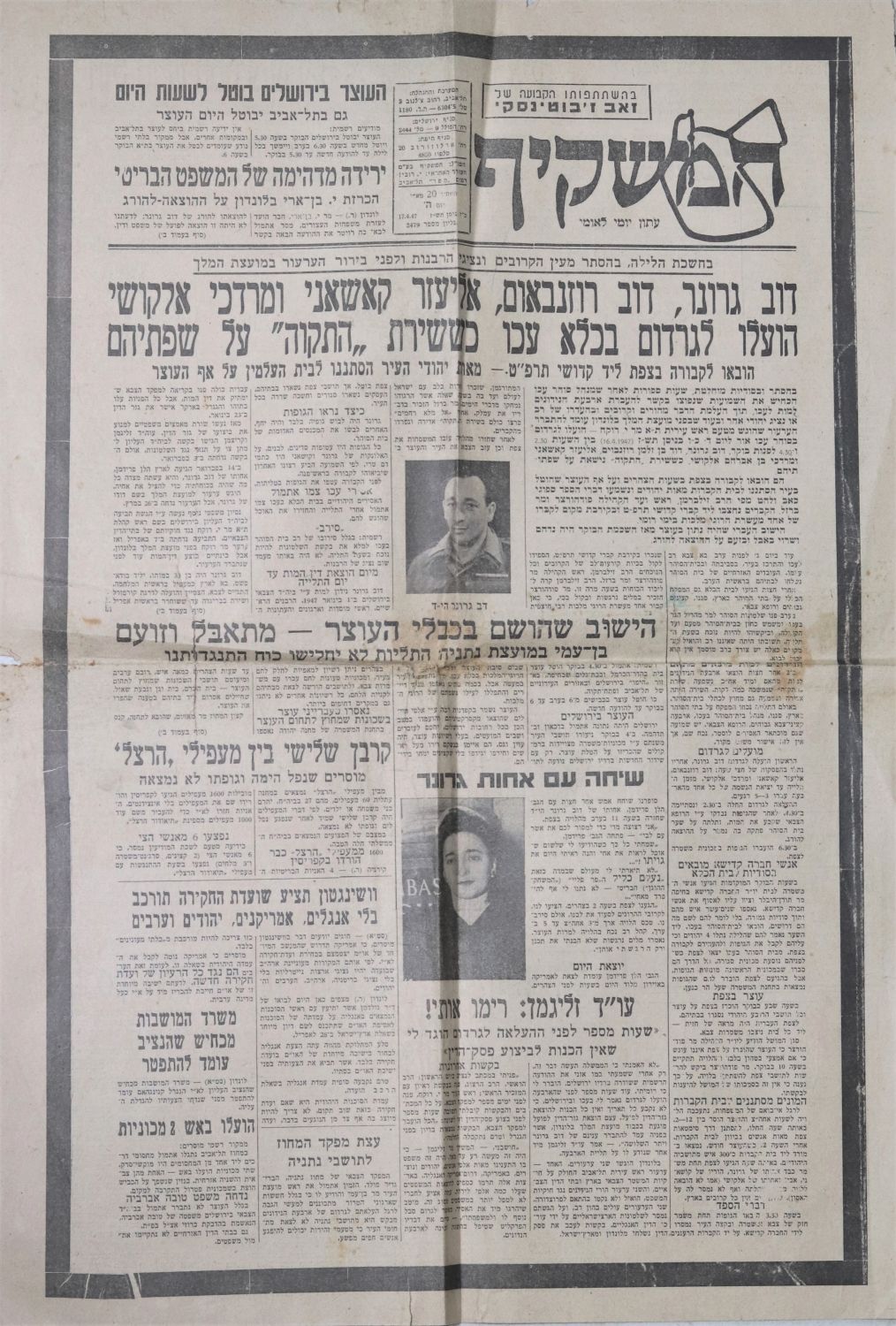
A special issue of "HaMashkif" newspaper dated April 17, 1947 announcing the hanging of the gallows pilgrims (Oley HaGardom), entitled: "Dov Gruner, Dov Rosenbaum, Eliezer Kashani and Mordechai Alkushi were hanged in Acre Prison while singing "Hatikva" ". The title page is surrounded by a black mourning frame. Extensive articles on the title page, and the reactions of the Jewish community.
In the subtitle: "They were brought for burial in Safed near the saints of 1929 - hundreds of the city's Jews infiltrated the cemetery despite the curfew" Another Jewish representative ... ". It is also reported that the four death row inmates in Acre were hanged "in secret and in complete secrecy ... while hiding the thing from parents and relatives and in the absence of rabbi or Jewish representative ..." , and more.
[2] p. Folding marks. Stains. Slight tears. Good condition.

A special miniature prayer order for the overthrow of the enemies during the War of Independence. "The virtue from an old manuscript kabalah from man to man until Moshe Rabbeinu Zia'a to fight with the enemies and defeat them and casualties fell before Bnei Yaakov and this is the order...", on the front and back cover printed the Israeli flag. Without specifying a year of printing. In the National Library, it is dated to the year 1948 according to Gershom Shalom. And in a comment there, Gershom Shalom was quoted as saying: "1948, given to soldiers in Jerusalem. A virtue for the soldiers of the war - a collection of prayers and verses given to the soldiers in Jerusalem".
On the first page is an illustration of Rachel's tomb. In the special 'Seder' was printed 'Vayehi Noam', 'Lecha Hashem HaGadulah', names of angels and prayer for the overthrow of the enemy: "אשאל השאלה הזאת מלפני עלת כל העלות ברוך הוא וברוך שמו שתצילני מהאויב הרע הזה ומאנשי הצבא שלו ויפלו חללים חללים ותשליך אימה וחשיכה גדולה ותרדמה עצומה ובהלה ושגעון ועורון ותמהון לבב על כל אויבינו... תצילנו מהפצצות והיריות של האויב ומהריסת בתים...ונחזור לבתינו לחיים טובים ולשלום", and various verses to overthrow the enemies.
8 pages, 8.5 cm. Good condition.

Collection of rare paper items of the JNF. Years: 1928-1932, and 1948.
*
Five special envelopes "New Year's greetings from Israel" which were specially designed by the JNF on the occasion of the first Independence Day in the State of Israel in the month of Elul 1948. Each envelope stamped with a Hebrew postage stamp and the inscription: "Rosh Hashanah greetings from Israel" was inserted - the first day envelope of Dar Ivri 1948 with six Dar Ivri stamps 3-50 values. On these envelopes which were specially designed with a red medallion in which it is written: "The gift of the Jewish National Fund Jerusalem". Inside each envelope was inserted a page "Happy New Year greetings from Jerusalem for the first Rosh Hashanah for Israel's independence in our country" - Excited words to the Jews in the Diaspora by Dr. A. Granovsky, Chairman of the Board of the Jewish National Fund "Regarding the Great Revolution of the Jewish People" The campaign that is still going on.
*
18 printed pages of the KKL - JNF Main Bureau in Jerusalem prepared for the 17th World Zionist Congress held in Basel in 1931 , relating to the promotion of Haifa Bay, recommendations to the World Zionist Congress, the KKL - JNF's relationship with Tzur Shalom, JNF activities in Transylvania, pages with summaries of JNF activities in the years prior to 1931, The JNF's attitude towards private manufacturing companies that were involved in its lands, and more. Most of the pages are dated: 1931, some of them signed in print by the chairman of the JNF a. Granovsky.
general condition very good.

A cartoon story painted as a long scroll depicting the upheavals of the Jewish settlement from the period of the First World War until the establishment of the state in 1948. "Name of the film: Three plagues of Egypt or 'changes that took place during 3 wars', dated: 1948. Unnamed illustrator. Gouache and ink colors on thick paper. Unknown.
Illustrator scenes one after the other, accompanied by descriptions in short sentences the war of the immigrants to Eretz Israel in the harsh conditions of the land - the heat, the fleas, the bees. Described below what he calls the 'change of apartments', first sleeping in a field on the ground, later around fences, and finally in houses built in the country. Then there is a chapter on 'Population Change' - the Hebrew aliyah takes over the local population - first immigrants come to Eretz Israel from different countries, then Holocaust survivors with armband patches, and finally fighters who loot the Arab enemy. the illustrator continues to describe funny scenes from kibbutz life, and finally "Attention to a few messages: Whoever has not yet changed his name will do so immediately, as well as a 'opportunities store' of loot looted from the Arabs, and planning the new Hebrew construction.
A long scroll, rolled to a length of about 3.5 meters. Height: 11 cm. Probably painted in one of the kibbutzim. Rare.
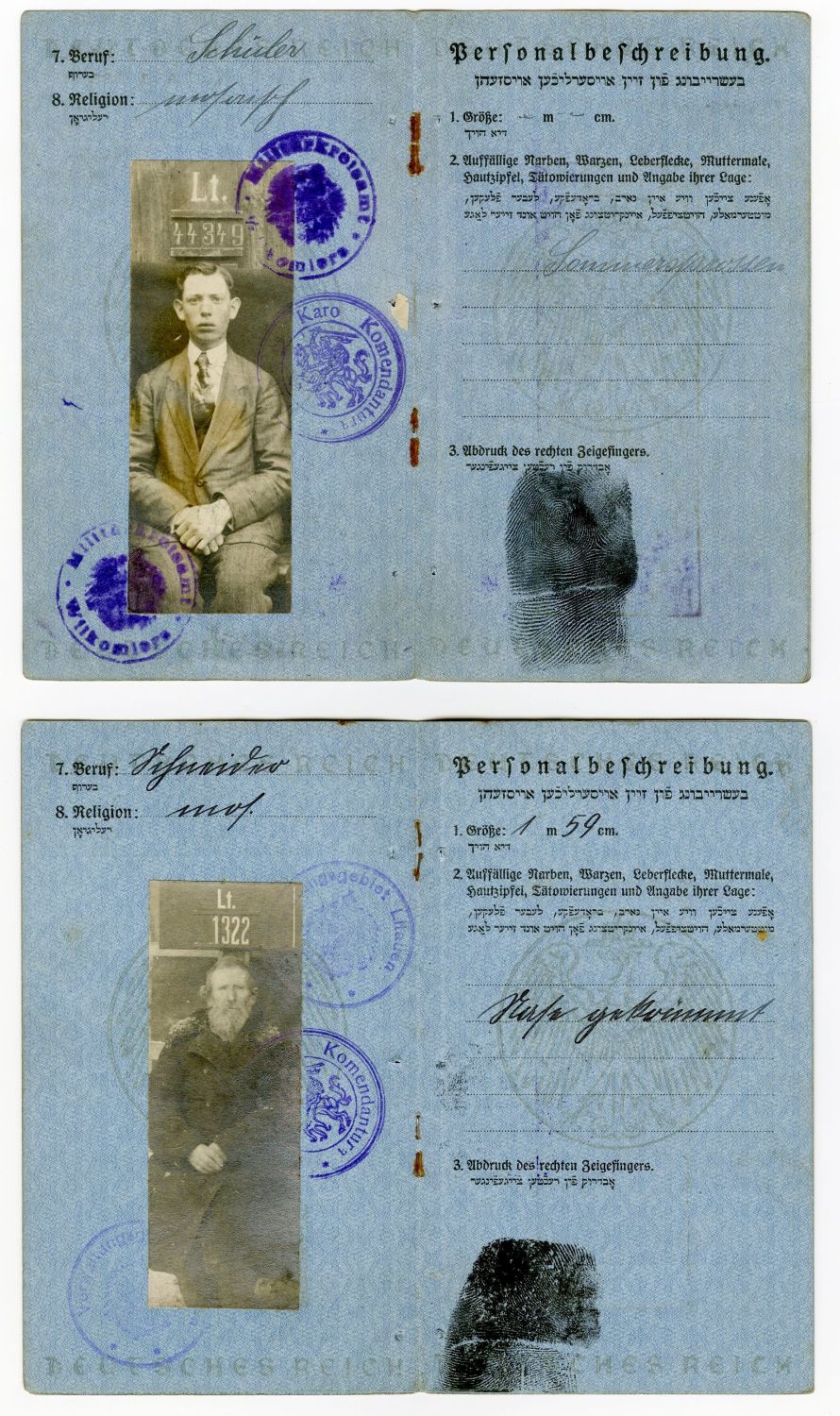
Pass [passport]. Two Jewish passport issued by the Gebiet des Oberbefehlshabers Ost [German administration in Ober-Ost] at the end of the First World War, with ink stamps "Verwaltungsgebiet Litauen" - the administration in Lithuania, and handwritten details.
* Passport of a Jew whose last name was Bolkao. In the passport is a photograph of the passport holder, born in 1841. His fingerprint, as well as ink stamps of the director in Lithuania. The details were filled in on February 8, 1918. [4] p. 15 cm. Few stains. Good condition.
* Passport of a Jew named Leib Schreiber. In the passport is a photograph of the passport holder born in 1898, his fingerprint, and ink stamps of the director in Lithuania. The details were filled in on September 2, 1919. [4] p. 15 cm. Few stains. Good condition.
The passports were issued by the German government in the territories occupied by Germany temporarily in the First World War [including Lithuania, Latvia, Estonia, Belarus, and territories from Poland and Korland]. The sections in which Yiddish and German. Among the provisions of the regulations are punishments ranging from five to ten years for a person who is found without a passport, a forged passport, etc. As well as penalties for a person who will not announce the loss of his passport within 24 hours.
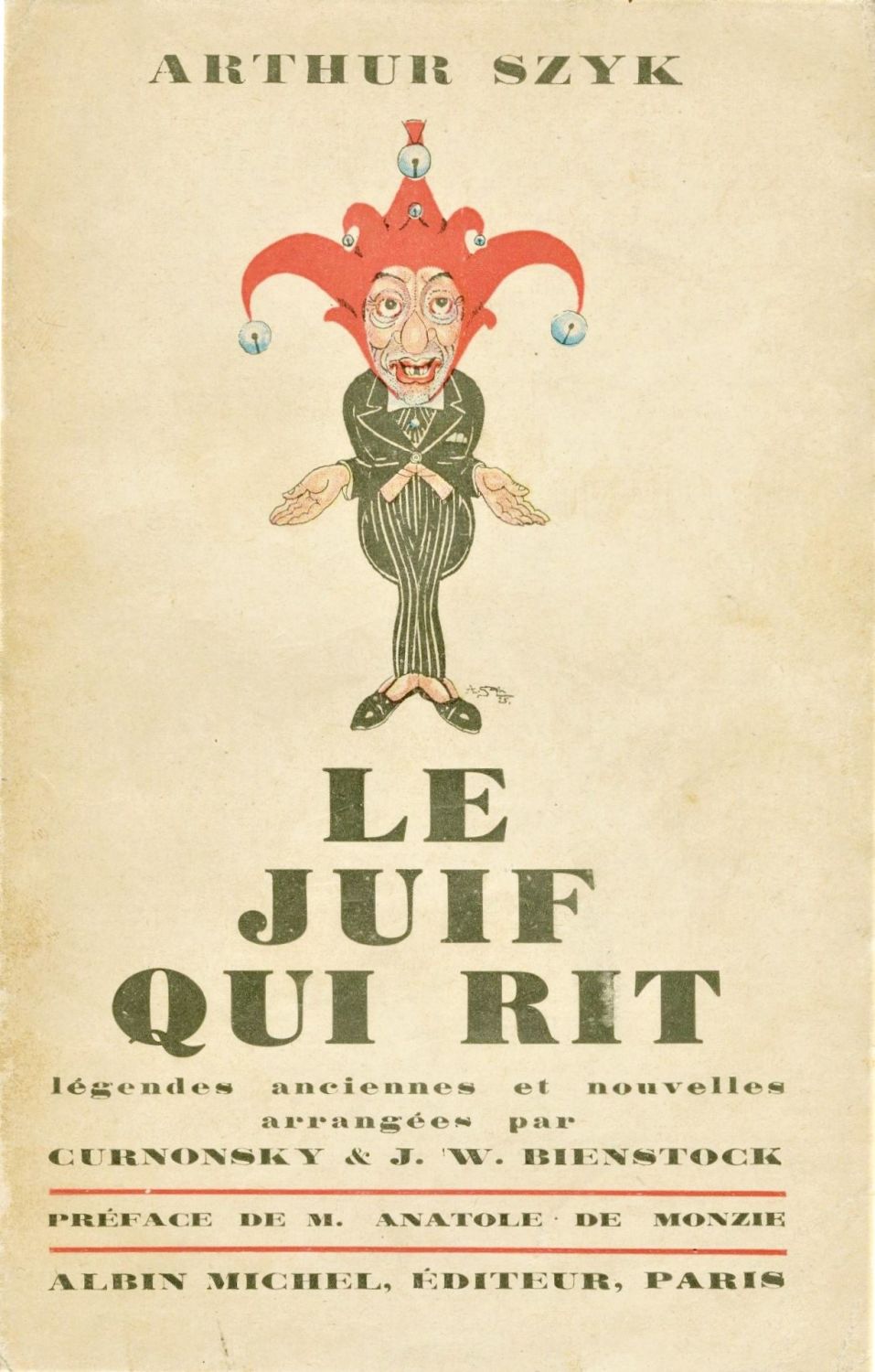
Le Juif Qui rit, Légendes Anciennes et Nouvelles [The Laughing Jew, Old and New Tales], edited by Curnonsky & J-W Bienstock, Introduction by M. Anatole de Monzie. Published by Albin Michel, Paris, 1926. French.
Humorous scenes from Jewish life in pre-war Europe divided into themes that surround Jewish life, accompanied by dozens of cartoons and humorous illustrations across each page depicted in short sentences by the artist Arthur Szyk. A rare book from the period of Szyk's early creation.
IV, 13-239 p. 19 cm. On some pages of the book sheets that have not been cut in print. Good - very good condition.
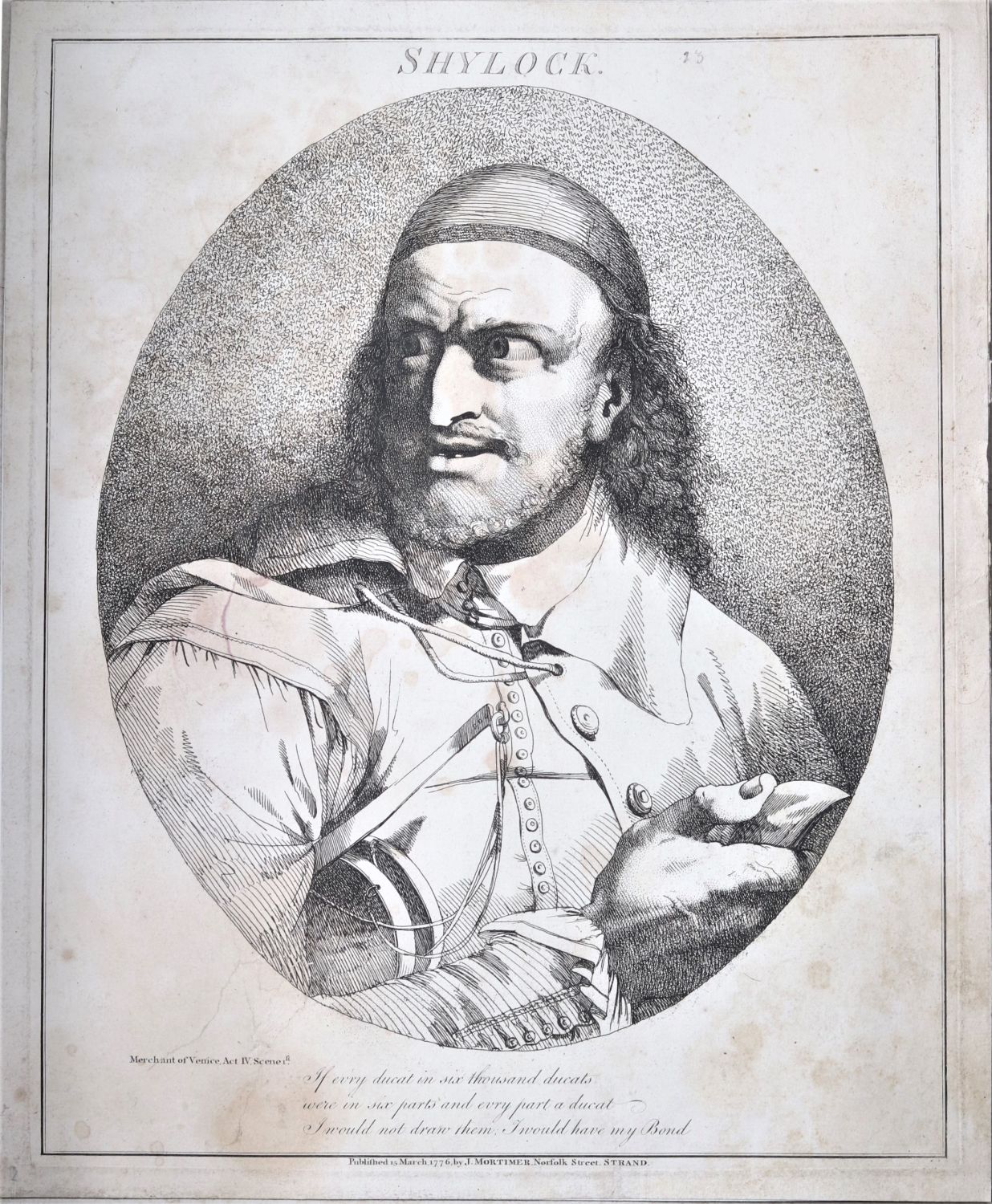
A large antisemitic engraving depicting the stingy Jewish Shylock Lending at interest from William Shakespeare's play "The Merchant of Venice" (written in the 16th century) in the scene of the knife, published by John Hamilton Mortimer - London 1776. (Printer details and the year of pulication below the engraving). Extremely rare.
The engraving depicts the scene in which Shylock holds a knife in his hand with a devilish look - according to a drawing presented in the Artists' Association in 1775. In the scene, the Jewish Shylock pursues greed Lend three thousand ducats to Antonio Christian, and terms with him in a written and signed note that if he does not return the money on time, the Jew will be allowed to cut a liter of meat from his body. Antonio lost his fortune and could not repay the debt, and Shylock, decided to take revenge on Antonio and to cut a liter of his flesh on the side of the heart. The engraving shows the Jewish Shylock holding the knife in his hand and preparing to cut Antonio's flesh on the side of his heart. At the bottom of the engraving appears the relevant passage from the play in which Shylock is preparing to sustain the intervention is quoted: "If ev'ry ducat in six thousand ducats / were in six parts and ev'ry part a ducat / I would not draw them: I would have my Bond".
The play accompanied by harsh antisemitic passages against the egoistic nature of the Jews, and it caused waves of antisemitic outbursts throughout Europe over the years, and whenever disagreements arose between Jews and Christians the play served as a backdrop for antisemitic stereotypical representation of the Jew as a threat to the decent Christian community.
Size: 43x35 cm. Thick paper. Glued to thick paper for storage.

LE PREFET DU DEPARTEMENT DE LA STURA - An antisemitic proclamation on behalf of Napoleon, forbidding Jews to use family names from the Bible ('from the Old Testament'), signed in print by Napoleon. Stura (an area in Italy annexed to France during Napoleon's rule) July 20, 1808.
In a special order issued after the conquest of Italian Stura by Napoleon's forces, the French sought to rearrange the surnames of the local Jews. The decree, which is divided into seven sections and an additional clarification entitled: "Imperial decree concerning juifs that do not have family names and fixed persons" - "Imperial decree concerning Jews who do not have a family name" , states that Jews often confuse the first name with The family, thus creating a situation where there are many Jews with no last name at all who are called only by their first name. Jews must adopt a last name within three months and declare the new name to the registrar of the local municipality in which they live. Article 3 states that: "The last name taken from the Old Testament will not be accepted as a family name, nor will any name of a Jewish city in which Jews lived in the past be accepted." Article 4 reinforces Article 3, which states that Jews must be informed of how the new installation is being carried out, and to tell the authorities Jews who choose a surname not in accordance with the regulation. "Jews found without appropriate surnames will be expelled from the territory of the French Empire." It is also written that the new regulation is contrary to what is accepted in the ancient Jewish tradition of the believing Jews who escaped from Egyptian bondage "because they did not change their name."
The proclamation is signed in print by Napoleon Bonaparte (Napoleon I). In those years, many Jewish families who chose to remain in place for fear of deportation were forced to use fake family names, according to the regulation. In 1814 Napoleon was defeated in the Italian sector, and the Jews of the French Empire regained Italian citizenship. Although it is known about a number of places where installation was still maintained even after the Italian reconquest.
Size: 64x44 cm. Folding marks. few stains. Very good condition.

LES MYSTERES DE PARIS ET LE JUIF ERRANT by Eugene Sue - Mysteries of Paris - The Wandering Jew - Issues 1-33 consecutive. Published by BERKIN et MANDON, Paris 1876.
A sequel story, accompanied by dozens of pictures about the 'wandering Jew''s damage to French society, and the Jew's danger to the regime's stability.
From the early publications published in France of the 'Legend of the Wandering Jew'. It is known about many later editions that came out for the story, before us the first edition - of the issues themselves as they came out one after the other ( do not bound in one large volume, as was done in later years).
33 consecutive sheets, numbered. Some have moisture stains and tears in the margins, no text damage. Good - moderate condition.

13 issues of the Jüdische Familien-Forschung - The Study of the Jewish Family - issues dealing with the Jewish family, its roots, and its ramifications - The Jewish research used by the Nazis against the Jews themselves. Berlin 1925-1929 (discontinuous issues).
The Gesellschaft für die Jüdische Familien-Forschung ("Jewish Family Research Society"), founded in 1924, began publishing the pamphlet, which aimed to connect Jewish genealogists and provide a platform for their research into the roots of German Jewish families. The editor of the issue, the ophthalmologist Arthur Czellitzer (1871-1943), believed that exposing the Jewish family lineage was especially important to the Jewish people. Since at that time he had no state, and most of the Jews did not speak Hebrew or any other language that would unite them, Czellitzer sought what would unite the Jews on a genealogical basis (as he writes in his preface to the first issue of 1924). Each issue deals with the history of the Jewish family and its origins according to the family names, and extensive information in its possession. Also in the issues appeared an 'supplement' known as "Suchblatt" in which the readers themselves participated in the writing and sent to the system the result of their research. The company published a total of 50 issues between the years 1924-1938. A title page with the names of the tribes of Israel appears on the covers of all issues.
Tragically, because dozens of Jewish surnames appeared in the various issues, as well as their origins and migration in various countries, and the whereabouts of families all over the world during the reign of Nazi Germany, The Nazis, who ordered to stop its distribution, took advantage of the large amount of information that appeared in them to persecute and murder the German Jews. Chelitzer himself was murdered in the Sobibor death camp.
before us sheets of the years:
1925 - Issue No. 4.
1926 - Issues 1, 4, 6, 7.
1927 - 1, 2, 3, 4.
1928 - 1, 2, 3, 4.
All sheets are complete. general condition very good

Le Traître!. Poster No. 6 from the Musée des Horreurs series ["Monsters Exhibition" / "Museum of Horrors"]. Paris, [1899-1900]. French. Hand-painted lithographic print depicting Alfred Dreyfus as a monster with a dragon body with aggressive snake heads. In the center of the dragon's body is a sword, with the inscription: "Le Traitre!" [The Traitor !, French]. Signed in the plate by V. Lenepveu. The poster was issued in November 1899 (About two months after Dreyfus received a pardon).
The series "Monsters Exhibition" was published during the Dreyfus affair under a pseudonym, and included 51 large posters with anti-Dreyfus illustrations, antisemitic, and against the "Bonim". The series was published in France over a period of about a year, between October 1899 and December 1900. The original plan was to issue 200 Posters in the series, but in fact only 51 came out. The first posters in the series sold over 300,000 copies. In October 1899 the French police arrested a number of peddlers who sold posters from the series on the orders of District Commander Louis Lapin. According to some reports, Lapin ordered the distribution of posters to be stopped following a request he received from Baron de Rothschild, who claimed that the damage in distributing them was irreversible. In February 1900 the local police sent letters in which they threatened to revoke the trade license from Merchants who would sell the posters, and since then their distribution has stopped.
65X50 cm. Slight tears in margins. Good condition.

Coquin. Poster No. 24 from the Musée des Horreurs series ["Monsters Exhibition" / "Museum of Horrors"]. Paris, [1899-1900]. A hand-painted lithographic print depicting the Jew Jacob-Paquin one of Dreyfus supporters, as a monkey dips the Cross of the Legion of Honor in a bidet. Paquin won the Legion of Honor on February 19, 1900 Which angered the anti-Dreyfus group who tried to prevent the award, claiming that by law at an advanced age they no longer receive the Medal of Honor, as part of the opposition this poster was issued about a month later, in March 1900. Signed in the plate by V. Lenepveu. French.
The series "Monsters Exhibition" was published during the Dreyfus affair under a pseudonym, and included 51 large posters with anti-Dreyfus illustrations, antisemitic, and against the "Bonim". The series was published in France over a period of about a year, between October 1899 and December 1900. The original plan was to issue 200 Posters in the series, but in fact only 51 came out. The first posters in the series sold over 300,000 copies. In October 1899 the French police arrested a number of peddlers who sold posters from the series on the orders of District Commander Louis Lapin. According to some reports, Lapin ordered the distribution of posters to be stopped following a request he received from Baron de Rothschild, who claimed that the damage in distributing them was irreversible. In February 1900 the local police sent letters in which they threatened to revoke the trade license from Merchants who would sell the posters, and since then their distribution has stopped.
65X50 cm. Slight tears in margins. Good condition.

Boule de Juif - Jewish ball. Poster No. 1 from the Musée des Horreurs series ["Monsters Exhibition" / "Museum of Horrors"]. Paris, [1899-1900]. A hand-painted lithographic print depicting the Jew Joseph Reinach (a French journalist and politician from Dreyfus' great supporters from the early stages of the trial) as a monkey holding a letter in his hand demanding revenge on a scoundrel made by D. "D" is a reference to one of the documents submitted by the prosecution in the Dreyfus case. Published: October 1, 1899. Signed in the plate by V. Lenepveu. French.
The series "Monsters Exhibition" was published during the Dreyfus affair under a pseudonym, and included 51 large posters with anti-Dreyfus illustrations, antisemitic, and against the "Bonim". The series was published in France over a period of about a year, between October 1899 and December 1900. The original plan was to issue 200 Posters in the series, but in fact only 51 came out. The first posters in the series sold over 300,000 copies. In October 1899 the French police arrested a number of peddlers who sold posters from the series on the orders of District Commander Louis Lapin. According to some reports, Lapin ordered the distribution of posters to be stopped following a request he received from Baron de Rothschild, who claimed that the damage in distributing them was irreversible. In February 1900 the local police sent letters in which they threatened to revoke the trade license from Merchants who would sell the posters, and since then their distribution has stopped.
65X50 cm. Slight tears in margins. Missing tear at bottom left without damaging text. Good condition.
Created and Develop with 🤍By webe ©2024